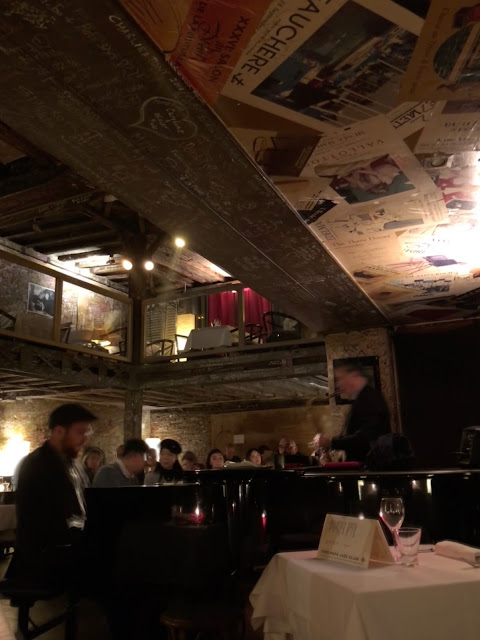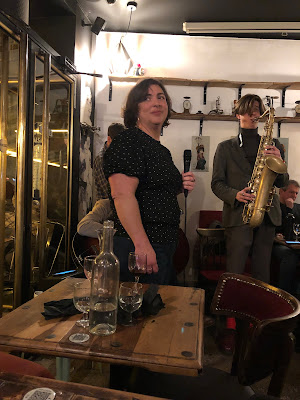Jazz Everywhere
 |
| Chez Papa, 7th Arr. |
I've lamented elsewhere that professional jazz is bumping up against a cruel arithmetic logic—namely, the paying audience gets older each year, with more listeners going to their rewards than are replaced by younger fans going to the shows. That seems true for jazz played in concert venues and recorded for albums (or whatever passes for albums these days), but less so for jazz played purely for the joy of listening to or making music—that is, jazz as a form of folk art or communal expression.
Two things have got me thinking about this lately.
The first is that we've fallen into a nice routine of having lunch occasionally at Café de Mars, a neighborhood place that has a jazz duo every Saturday. The duo consists of an immensely talented guitarist who is joined by a few rotating accompanists on violin, cello, or second guitar. The set list is jazz standards, played usually in the Hot Club style with touches of Wes Montgomery, Kenny Burrell, and Barney Kessel. Once or twice an afternoon, a serveuse named Adriana will request a song in a certain key and sing along while she takes orders or brings drinks and food to the tables. It's fairly magical since she not only has a great voice, but a great sense of timing that brings her back from the solo breaks at exactly the right moments—so she's not adding a verse just as a customer is saying whether want their steak saignant or à point, for example.
 |
| Café de Mars, 7th Arr. |
Adriana also tipped us off to her quartet that plays a restaurant called Côté Canal on Saturday nights. Whereas the lunch show at Café de Mars is intimate (befitting a duo), the dinner show is a bit raucous, not least because it's a packed place even as early as 8 PM (or 20h00 in the local fashion). But the band—a mostly acoustic affair of guitar, bass, sax/clarinet and coals—more than holds its own against the noisy and appreciative diners. A brass sound helps, but so does the set list, which was peppered with the likes of Fats Waller and other can't-miss stompers.


Côté Canal, 10th Arr.
Despite the fact that these are top-notch musicians playing with great skill and—just as importantly—great taste, both Saturday shows were strictly pass-the-hat affairs. And this is to my point that even if the audience for expensive theater shows by recording professionals may be aging out, there is still a pipeline for talent to find meaningful ways to be heard. And in between there are supper clubs such as Chez Papa, which book acts, have dinner seatings that correspond to show times, and add an entertainment fee to the bill of about 15 euros per person. This is still a pretty good deal—though personally I prefer the food at both Café de Mars and Côté Canal, not surprisingly, since these are first and foremost restaurants. Sometimes you are lucky enough to come across talented buskers on the street or down in the metro. The price is right, but it has to really click to make you deviate from wherever you are going in order to hang around.
 |
| A stone's throw from Odéon Théâtre, 6th Arr. They went to the trouble roll out the vibraphone, why not hang around awhile? |
The second thing that got me thinking about jazz performance as a vocation versus jazz performance as a personal or cultural practice was a visit to the Musée du Quai Branly's huge trove of art and artifacts from outside of Europe.
Being an ethnographic museum, and because the objects were collected mainly during France's long colonial period, there is an unavoidable exoticism attached to representations of different folkways. The curators acknowledge this troubled provenance and take pains to explain the variety of global customs within their own context (which makes the absence of a Europe section even more baffling; I've been to Alsace, a place that technically no longer exists but which continues to celebrate historic folkways). That is, we are a long way from anthropology's colonial roots and the disturbing French legacy of human zoos.


Enchanting artifacts from far-off Nouvelle Orléans, Louisiane, Amérique du Nord.
But exoticism aside, the objects on display are unquestionably unique works of art, even within the context of a single society or a specific art form. For example, ceremonial masks from Papua New Guinea displayed side-by-side drive home the cultural importance of the art form while also showing the variety the form takes.
 |
| A variety of ceremonial masks from Papua New Guinea, Musée du Quai Branly, 7th Arr. |
What got me thinking was that for all the artistry on display, unlike museums that focus on more modern art forms—say, from the Renaissance, forward—none of the items listed any artist's names. Not even "anonymous" to acknowledge that individuals poured their skill and dedication into what turned out to be a museum-worthy piece. This is also true of museum pieces from older civilizations, such as pottery from ancient Greece or tapestries from medieval Francia. There is genius on display, but it's the collective genius of the society which develops, nurtures, and passes on the craft, not the contributions of any individual geniuses.
 |
| Australian Aboriginal art on eucalyptus bark. Click image to view more detail. |
And there certainly must have been geniuses at work somewhere in the development of these crafts, even though the provenance is lost to curators and museum-goers. There are differences in skill and accomplishment in everything that humans do. Even in "traditional" societies, it makes sense that different artisans would find new ways of doing or expressing things that just caught on and spread. What else would explain all the variety on display at Quai Branly and the observable changes in the arts over time?
Maybe the changes happened incrementally, in a Darwinian fashion—one person makes a slight improvement here, another adds a new color or material there, and one generation's baskets are noticeably different than the baskets from their great-grandmothers' generation. Maybe one person discovers an innovation (for lack of a better, less culturally-freighted word) that radically changes an art form all at once—in the same way that no high-jumper would ever cross the bar face-first after Dick Fosbury's flop.
It's understandable that environmental, social and political conditions play a big role in fostering innovations. Innovations in jazz itself can be traced back to the trans-Atlantic slave trade, the relaxed slave codes in Francophone and Catholic North America that permitted greater artistic expression among enslaved people, the surplus of brass instruments after the Civil War, the Great Migration northwards, the popularity of affordable home radios, fuel rationing during the Second World War, and the civil rights movement (broadly speaking). But the craft practice doesn't necessarily stop if for whatever reason the conditions for innovation dry up (or if innovation occurs so slowly that it's unnoticeable, even to the artisans). It just becomes "traditional." As good as ever, but no longer dynamic.
What I'm suggesting, naively, and mainly to myself, is that art forms may generally tend towards anonymity, which is to say, towards reproducible craft. That would apply to jazz as well—which may be the reason why it lasts in the long run.
One objection to this idea that jazz is veering towards anonymous folk art is: "Hey, Dummy, the reason we don't know who made that mask/robe/spear/basket/whatever is because the community the maker lived in didn't keep track of that kind of stuff, or if they did, they just lost track of it over time. Even if the collector tried to find out who made it (yeah, right), no one could have told him."
Which is undoubtedly true. But it's also just another way of restating my premise as a new, potentially answerable question (which is my prerogative, since I'm arguing with myself and am unencumbered by any actual knowledge of, or training in, art history or musicology). Why didn't ancient and traditional societies attach provenance to artistically or culturally significant objects? Generally speaking, societies remember and pass on stories of significant personages from their past—not just in writing but in all sorts of oral and artistic traditions. Since there are almost always hierarchies of prestige at play, communities would have been able to identify among themselves when someone was more skillful than others at a craft, or who did something differently that seemed to work in its own way. If this is not fame as modern people understand it, it's at least notoriety, if not honor. It's telling that few examples of significant artisans from ancient and folk societies have been passed downwards.
So it could be the case that jazz's era of incremental or revolutionary change—and with it, its era of heroic artists from, let's say, Scott Joplin's ragtime through John Coltrane—has come and gone. While there continue to be big-name, full-time professional recording artists like Jon Batiste and Cécile McLorin Salvant, for the most part they're making great music in the established traditions—standing on the shoulders of giants—and performing live in theaters for older, affluent audiences.
But what may really keep the form alive are school bands, youth workshops and small combos passing the hat in cafés, subway stations and street fairs (or just on the corner). I'll try to keep that in mind when the Festival Jazz à Saint-Germain-de-Prés rolls around again this year. Maybe I'll just go poke around a métro station instead.



Comments
Post a Comment